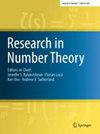Fast norm computation in smooth-degree Abelian number fields
IF 0.8
Q3 MATHEMATICS
引用次数: 1
Abstract
Abstract This paper presents a fast method to compute algebraic norms of integral elements of smooth-degree cyclotomic fields, and, more generally, smooth-degree Galois number fields with commutative Galois groups. The typical scenario arising in S -unit searches (for, e.g., class-group computation) is computing a $$\Theta (n\log n)$$光滑阿贝尔数域的快速范数计算
摘要本文给出了一种快速计算光滑分环域的积分元的代数范数的方法,更一般地,给出了具有可交换伽罗瓦群的光滑伽罗瓦数域的代数范数。在S单元搜索(例如,类-组计算)中出现的典型场景是计算权重为$$n^{1/2+o(1)}$$ n 1 / 2 + o(1)的元素的$$\Theta (n\log n)$$ Θ (n log n)位范数在度- n字段中;这个方法然后使用$$n(\log n)^{3+o(1)}$$ n (log n) 3 + o(1)位运算。$$n(\log n)^{O(1)}$$ n (log n) O(1)个运算次数在两种更简单的特殊情况下是已知的:从2次幂的环切域通过2次幂的环切子域的塔的模,以及从多二次域通过多二次子域的塔的模。本文通过识别支持快速乘法的塔兼容积分基来处理更一般的阿贝尔域;特别是,在塔兼容的高斯周期积分基和Rader的快速乘法思想之间存在协同作用。作为基准,本文还分析了适用于任意数字字段的各种标准规范计算技术,得出的结论是,所有这些技术在相同的场景中至少使用$$n^2(\log n)^{2+o(1)}$$ n 2 (log n) 2 + o(1)位操作,即使使用用于连分式和复杂fft的快速子程序。与此基线相比,专用于光滑度阿贝尔域的算法查找每个范数的速度要快$$n/(\log n)^{1+o(1)}$$ n / (log n) 1 + o(1)倍,并且在S -unit搜索中完成范数计算的速度要快$$n^2/(\log n)^{1+o(1)}$$ n 2 / (log n) 1 + o(1)倍。
本文章由计算机程序翻译,如有差异,请以英文原文为准。
求助全文
约1分钟内获得全文
求助全文
来源期刊

Research in Number Theory
MATHEMATICS-
CiteScore
0.80
自引率
12.50%
发文量
88
期刊介绍:
Research in Number Theory is an international, peer-reviewed Hybrid Journal covering the scope of the mathematical disciplines of Number Theory and Arithmetic Geometry. The Mission of the Journal is to publish high-quality original articles that make a significant contribution to these research areas. It will also publish shorter research communications (Letters) covering nascent research in some of the burgeoning areas of number theory research. This journal publishes the highest quality papers in all of the traditional areas of number theory research, and it actively seeks to publish seminal papers in the most emerging and interdisciplinary areas here as well. Research in Number Theory also publishes comprehensive reviews.
 求助内容:
求助内容: 应助结果提醒方式:
应助结果提醒方式:


